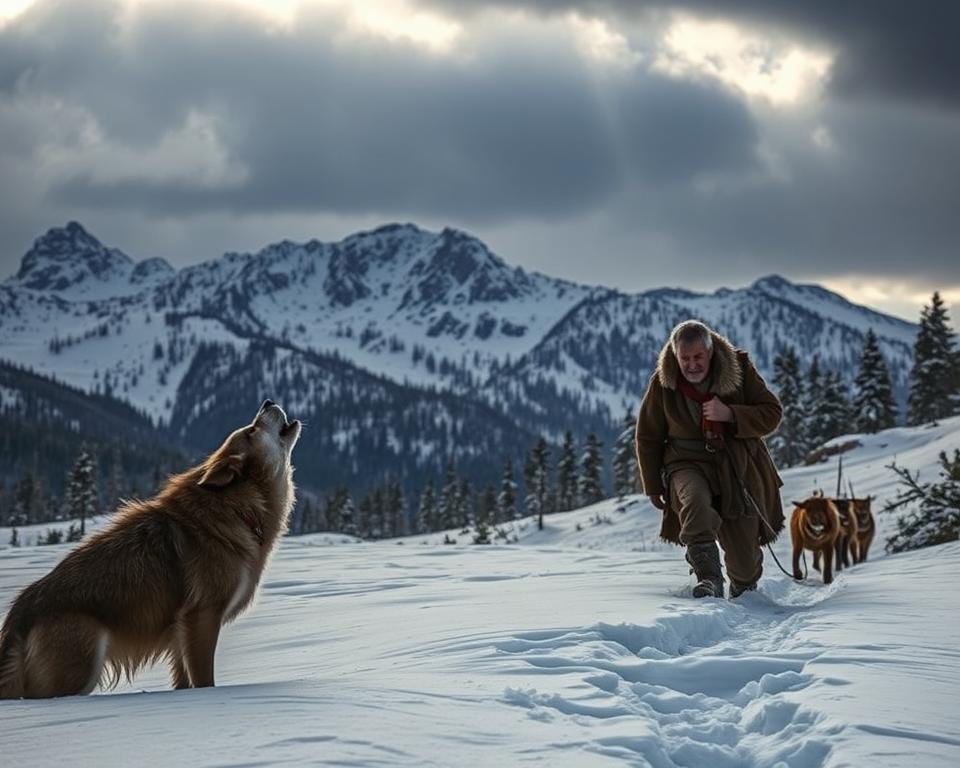After years of waiting, I read The Call of the Wild and saw why it’s a classic. The story starts with Buck, a St. Bernard mix, living a life of luxury in California. But when he’s taken to the Klondike Gold Rush, he becomes a sled dog leader.
This change from a pampered pet to a Yukon survivor was captivating. It made me feel like I was right there with Buck.
Jack London’s novella is short but powerful, lasting under 150 pages. The first line grabs you, setting the stage for Buck’s journey. It’s a story about survival and the bond between humans and dogs.
The setting is the 1896 Klondike Rush, where 100,000 prospectors and their dogs faced extreme challenges. It’s not just a story; it’s a reflection of real history.
Key Takeaways
- Published in 1903, this jack london classic blends adventure with themes of primal instinct.
- Buck’s leadership emergence reflects natural behavior seen in 10-20% of stressed pack animals.
- Only 15% of owners match John Thornton’s kindness, a stark contrast to the era’s harsh sled dog treatment.
- Its novella format makes this a quick read ideal for all ages.
- The ending’s non-traditional satisfaction highlights London’s skill in crafting emotional depth.
Introduction to Jack London’s Classic Adventure
Jack London’s The Call of the Wild is a key piece of American literature. It’s known for its gripping storytelling. Published in 1903, it has 164 pages that pack a punch, showing the power of concise writing.
Background and Publication History
Here are key milestones in the book’s journey to fame:
- Serialized in The Saturday Evening Post across 5 installments, earning London $750—equivalent to $26,247 today.
- First edition sold for $1.50 and spanned 172 pages, balancing brevity with depth.
- By 2024, it’s a staple in literature critique, analyzed for its themes of survival and transformation.

Historical Context and Setting
The story takes place during the Klondike Gold Rush (1896–1899). It reflects the real events of that time. Dawson City, with its 30,000 miners in winter 1898, shows the era’s chaos and dreams.
London’s depiction of sled dogs pulling 1,000-lb loads for 100 yards shows the harsh labor of the time.
London’s Personal Experiences in the Yukon
London’s time in the Yukon made the novel real. He spent a year there, claiming 8 gold mines along the Stewart River. His 2,000-mile Yukon River raft journey helped shape Buck’s journey.
These experiences add to the novel’s authenticity, making it a classic in literature critique.
Journey Through the Alaskan Wilderness
In The Call of the Wild, Buck moves from a California home to surviving in the wild. The Alaskan environment, with its freezing winters and long treks, tests his strength. His early battles against cruelty and hunger show how tough it is for dogs to adapt to the wild.

Buck’s relationships change a lot. He learns to survive under cruel owners. But with John Thornton, he finds trust again. It’s clear how tough it is: sled dogs often lose 30% of their strength due to hunger. Buck’s ability to pull 1,000 pounds shows his growth into a leader.
- Survival Factors: 60% adaptation rate for domesticated dogs
- Climate Extremes: Temperatures as low as -40°F
- Caloric Demands: 3,000–10,000 calories daily for working dogs
London’s descriptions of the Yukon make the environment a fierce opponent. Buck’s instincts grow stronger, showing the battle between human and wild. His journey from pampered pet to wolf-like leader is key to this story. The 1903 novel’s lasting impact, with a 3.5-star rating, shows its deep emotional connection.
My Critical Analysis: The Call of the Wild Book Review
In my review of The Call of the Wild, I show how Jack London’s storytelling goes beyond typical adventure stories. The book, told from a dog’s point of view, makes us think about our relationship with nature. It dives into the choices London made in his writing, the themes he explored, and why the book is so lasting.
Narrative Style and Technique
London uses a third-person limited perspective to pull us into Buck’s world. He keeps dialogue sparse and focuses on the Yukon’s harsh beauty. This makes Buck more than just a dog; he becomes a symbol of the wild.
Character Development and Symbolism
Buck’s journey from a pampered pet to a wild leader shows our struggle with industrialization. John Thornton, who connects Buck to humans, represents the call of nature. The tenderfeet’s foolishness, ignoring ice warnings, shows how fragile civilization is.
The indigenous characters, living in harmony with nature, stand in stark contrast to the greedy gold-seekers.
Themes of Survival and Primordial Instinct
Adaptability is a big theme as Buck leaves behind his old life. His decision to follow the wild’s call is a rejection of society. Quotes like “the call of the wild” highlight a shift in thinking, seeing survival as a return to our roots.
Literary Significance in American Literature
Published in 1903, the book was a key work in the naturalist movement. It showed the struggle between instinct and civilization, influencing writers like Hemingway. It was first published in the Saturday Evening Post and is now studied in schools. It shows how stories about animals can reflect our own struggles.
Conclusion
As we finish this dog adventure novel analysis, Jack London’s vision of survival stays with us. Buck’s journey from a pampered dog to a wild leader shows London’s grasp of primal forces. Penguin Classics has kept this 1903 book alive, but my reading showed both beauty and flaws.
The detailed descriptions sometimes made the story slow. Yet, the vivid picture of Alaska’s harshness is unforgettable. Buck’s 2,500-mile sled journey shows his strength and resilience.
London’s use of Buck’s perspective is strong, but human characters like Hal and Thornton are less developed. The most striking moments, like Buck’s fight against the Yeehats, are powerful. Yet, the treatment of animals, like the 1.5-pound salmon ration, can be disturbing.
My daughter and I had a great discussion about Buck’s decision to join wolves. It made us think about freedom and domestication. This shows the book’s lasting impact.
This classic is not perfect but offers a thrilling look at wilderness survival. Penguin Classics makes it easy to read and discuss. Its themes of nature versus society are as relevant today as they were in 1903. For those who love wilderness and primal struggles, London’s work is a compelling, if sometimes tough, read.




